
Geneva Motor Show: optimism roars back
Lamborghini, Bentley, Aston Martin, Audi, Hong Kong's Infiniti, Mercedes-Maybach, McLaren and Ferrari among marques unveiling a total of 90 road models and concept cars
Out with the gloom, in with the boom: sleek luxury sports cars, high-end SUVs and nifty little city cars were bumper-to-bumper when the Geneva Motor Show opened to the media.
Thousands of journalists milled through the vast halls of the show, one of the car industry’s biggest and most diverse events, examining the vast array of vehicles in all shapes and sizes on display.
From small city cars for everyman to horsepower-infused “supercars” carrying six-digit price tags, the Geneva Motor Show this year is showcasing some 900 cars.
And with 90 sleek never-before-seen machines making their world premieres in Geneva, the 85th edition of the show appears to be revving up to be one of the most spectacular on record.
The some 220 manufacturers showcasing their new beauties in Geneva are expected to be in high spirits as the long-suffering European car industry looks poised to swerve into the fast lane.
One model that is guaranteed to generate a lot on interest in Lamborghini’s most ferocious bull, the V-12-powered Aventador, which is getting an upgrade.
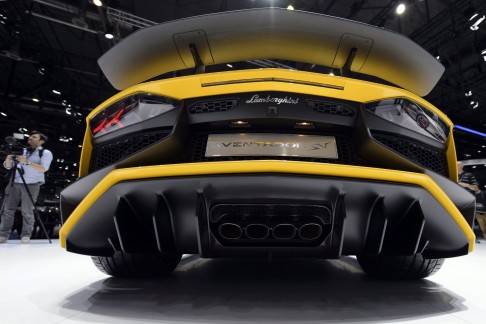
The Italian carmaker unveiled a modified version of the mid-engined supercar on Monday night ahead of the show in Geneva.
Dubbed the 750-4 Superveloce (SV for short), this new iteration adds power and subtracts weight from the base Aventador, which will remain in production. The SV’s debut comes four years after Lamborghini released the original Aventador at the 2011 Geneva show.
The basics of the supercar’s recipe remains unchanged: a 6.5-litre V-12 engine, all-wheel-drive, and a single-clutch, seven-speed automated transmission are bolted to a carbon fibre passenger shell and aluminum front and rear subframes.
But Lamborghini tweaked the engine’s valve timing, intake system and exhaust, which bumped output to 740 horsepower (the car has 750 metric horsepower, hence its name) from a previous 691 horsepower. Torque remains 690 Newton metres (Nm).
This means a zero-to-100km/h run now takes 2.8 seconds and top speed is “over 217 mph” (350km/h) according to Lamborghini.
The carmaker also dropped about 50kg of weight by making various body panels (fixed rear wing, door panels, engine cover) out of carbon fibre. And the pushrod suspension now gets adaptive damping similar to the excellent system in Lamborghini’s lesser Huracan.
“The new Aventador Superveloce continues the Lamborghini tradition of SV models, pushing the boundaries in terms of performance and pure driving emotion,” Stephan Winkelmann, Lamborghini’s CEO, said ahead of the car’s debut.
The Aventador SV will land at dealerships later this spring. Pricing will be announced in the coming weeks. It won’t be cheap. The more basic Aventador we tested in 2012 cost US$412,145.
Bentley
Bentley, meanwhile, is considering adding a fifth model to its growing line-up and used the Geneva Motor Show to reveal the EXP 10 Speed 6 concept.
The sultry design of the new two-seat coupe makes up for the awkward name – which will change if and when the EXP 10 reaches production. That could happen: Bentley’s latest addition to the family – the Bentayga SUV due later this year – debuted at the 2012 Geneva show as the EXP 9 F.
“The EXP 10 Speed 6 is one vision for Bentley’s future – a powerful, exquisite and individual concept,” said Wolfgang Durheimer, chief executive of Volkswagen Group-owned Bentley. “The show car has the potential to be the new pinnacle luxury two-seat sports car.”
The new model would be positioned alongside the existing Continental GT V-8, the base version of Bentley’s most popular model in history. No powertrain details were announced, though they’ll likely be similar to the all-wheel-drive Continental: a twin-turbocharged 4.0-litre V-8 that makes 500 horsepower and 660Nm of torque.
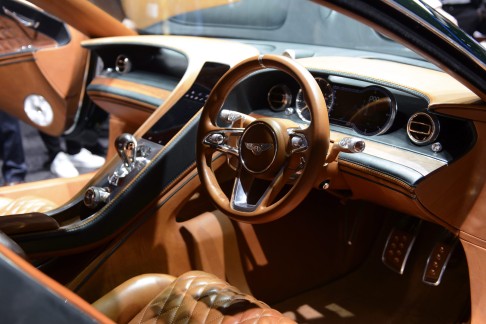
The design of the EXP 10 also previews what Bentley’s design future holds. The current look – on the Continental GT coupe and convertible, its Flying Spur sedan counterpart, and the top-end Mulsanne sedan - is handsome but getting worn out after years of moderate changes.
The EXP 10’s face is a dramatic interpretation of the current cars’ quad-headlight design, with a large, egg-shaped main light flanked by a smaller LED unit on the outside. The rear of the car is more horizontally oriented than the rounded look of the current Continental.
The two-seat EXP 10 coupe sits lower than the Continental and has a sleeker, more streamlined profile. The mesh grille, door handles, exhausts and side vents are all 3D printed metal, a bleeding-edge technique whose cost may be prohibitively high on the production coupe.
It’s too early to tell what Bentley would charge for such a coupe if it does reach production. Given that it would be a counterpart to the Continental GT V-8, the EXP 10’s price could start in the same US$177,000 ballpark.
Aston Martin
Looking to capitalise on the highly profitable trend of building track-only supercars, Aston Martin used the show to debut the Vulcan.
The front-engine, rear-wheel-drive Vulcan is made entirely of carbon fibre and packs a massive 7.0-litre, V-12 engine that makes more than 800 horsepower (exact power and performance figures will be announced later).
“A sports car for true sports car lovers, I believe the Aston Martin Vulcan – and the unique ownership programme that sits behind it - sets a whole new standard in the ultra-high luxury supercar class,” Andy Palmer, Aston’s CEO, said ahead of the debut.
The Vulcan joins the likes of McLaren’s P1 GTR (also a Geneva debut) and Ferrari’s FXX K – track cars that are as rare as they are expensive. Aston will build just 24 of the cars globally, with a price tag of about US$2.3 million each.
A sports car for true sports car lovers, I believe the Aston Martin Vulcan ... sets a whole new standard in the ultra-high luxury supercar class
For that money, buyers get the powerful engine mentioned above plus carbon ceramic disc brakes, a six-speed sequential gearbox, variable traction control and a fully-adjustable suspension. Buyers can order the car in any colour they like.
They also get a detailed driver training programme and car support at tracks around the world, as well as seat time in other Aston Martins as buyers presumably work up the courage to flog US$2.3 million worth of machinery around a racetrack.
The programme is similar to those run by McLaren and Ferrari for buyers of their track-only supercars. The astonishingly rare opportunities curry favour with a carmaker’s best (and wealthiest) customers.
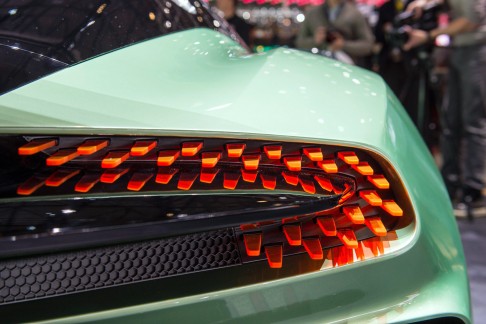
The Aston Martin Vulcan is set to hit the world’s tracks in 2016.
In addition to giving the tiny carmaker something to show off at the Geneva show, the Vulcan’s design also hints at what future production Astons may look like. The company is in the middle of a wholesale product reinvention, the fruits of which should first appear in the successor to the DB9.
A DB10 concept car was unveiled at the end of 2014 when it was announced that Daniel Craig’s James Bond character would drive the car in the upcoming Bond instalment, Spectre.
Audi
More than two years since abandoning electric cars, Audi has returned with the R8 e-tron, in a move that looks more like an attempt to keep its options open than a full conversion to the technology.
Battery-powered cars have failed to live up to their initial hype, with drivers put off by the slow rollout of recharging stations, limited range and high prices – despite generous sales incentives in some markets.
By 2020, fewer than one in 20 vehicles produced is forecast to be equipped with electrified powertrains, business consultants KPMG said in January.
Audi, the flagship brand of German carmaker Volkswagen, has been reluctant to embrace the technology, arguing it was better to make diesel cars cleaner or focus on hybrids that combine a combustion engine with battery power.
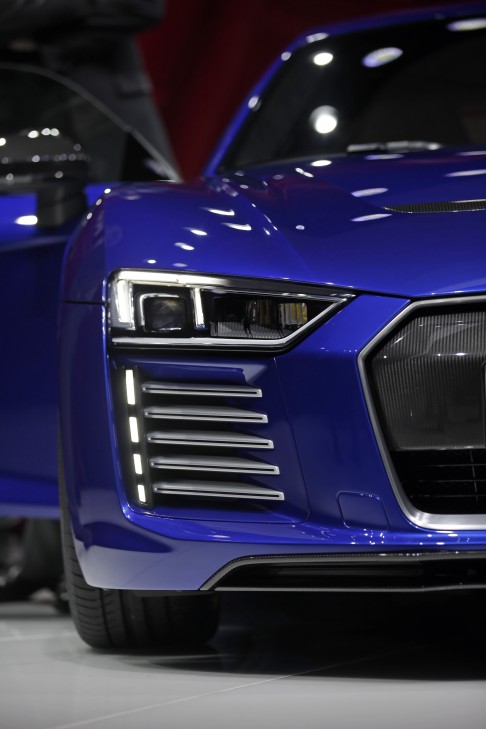
It flirted with an electric R8 sports car in 2009, promising a thrilling performance but an underwhelming range of 216km. It wasn’t enough, and Audi dropped the concept in 2012, the year rival Tesla’s Model S came out with double the range.
However, Tesla’s success, and that of Audi’s arch-rival, BMW with its “i” series of electric cars, appears to have convinced Audi there is a market for electric supercars after all.
A fully electric R8 may also help Audi get closer to meeting rigid EU emissions limits. Audi came 18th last year in a survey of Europe’s 20 top-selling brands’ average CO2 output, auto industry forecaster JATO said on Tuesday.
At the Geneva show, Audi unveiled an emission-free version of its ¤165,000 R8 that can travel 450km before needing to recharge, which takes less than two hours.
The battery’s capacity has almost doubled to 92 kilowatt-hours (kWh) from 49 kWh in the aborted 2012 model, a source said.
That has helped more than double the range of the carbon-fibre R8 e-tron, which surges to 100km/h in 3.9 seconds, compared with 3.2 seconds for the 540-horsepower model.
Such projects are no practicable means to leverage electric driving over the short term
Audi may also launch two battery-powered serial models by 2018, a sports car and a sports-activity vehicle with over 500km of range to rival Tesla’s upcoming Model X SUV, two company sources said.
However, analysts said Audi was treading cautiously, not least because it only plans to build the R8 e-tron by request.
“Such projects are no practicable means to leverage electric driving over the short term,” said PwC analyst Christoph Stuermer. “They only help minimise the business risk.”
Sales of the R8 e-tron probably won’t exceed 100 a year until 2022, research firm IHS Automotive forecast. By comparison, IHS expects deliveries of Tesla’s Model S to grow 14 per cent to 41,396 cars by 2022 from 36,364 this year.
Infiniti
Hong Kong-headquartered Infiniti has had a busier Geneva Motor Show than most this week, debuting two concept vehicles that are expected to reach production in the near future.
The QX30 compact crossover and the Q60 sports coupe offer a sneak peek of what’s to come from Infiniti, the luxury arm of Nissan.
The coupe will arrive on the road first.
“The Q60 concept is more than a design exercise; it is earmarked for production,” Roland Krueger, Infiniti’s CEO, said ahead of its debut. “What you see in this concept vehicle inspires the sports coupe that Infiniti will produce next year.”
That 2016 coupe is based on Infiniti’s existing Q50 sedan, and will compete with other two-door sports coupes such as the BMW 4 Series, Cadillac ATS coupe, Lexus RC, and Audi A5. Power will come from a new 3.0-litre, twin-turbocharged V-6 that Infiniti plans to roll out in other models in the next two years.
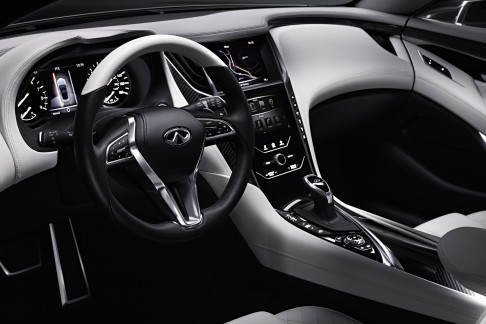
Power figures haven’t been announced but the engine will need at least 300 horsepower to keep up with its rivals. Based on what its rivals charge, the Q60 should sell for US$40,000 to US$50,000.
On the smaller side of Infiniti, the carmaker also showed off the QX30 concept. This tidy little crossover vehicle looks to jump into the ultra-hot compact arena that every other luxury brand is salivating over.
Lincoln, Audi, Lexus, Mercedes-Benz and Porsche have released new models looking to capitalise on the growth in this segment, which is fuelled primarily by young couples buying their first luxury vehicle, as well as by empty nesters downsizing.
“The QX30 concept foreshadows an entry in the premium compact segment that provides a stylish alternative to the existing offer in this segment,” said Krueger.
The vehicle is specifically styled to lure Gen X and Gen Y shoppers, whom Infiniti expects to make up 80 per cent of the segment by the end of the decade.
The QX30 is based on the recent Q30 four-door hatchback that goes into production later this year. Infiniti will begin building this QX version in 2016. Infiniti – the only carmaker with its global headquarters in Hong Kong – hasn’t released details on what will power the QX30 and the Q30, but it’s expected to use a turbocharged four-cylinder engine sourced from Mercedes.
Pricing is another unknown, but the general price of admission in the luxury compact crossover world is at least US$30,000.
Agence France-Presse, Reuters, Los Angeles Times

